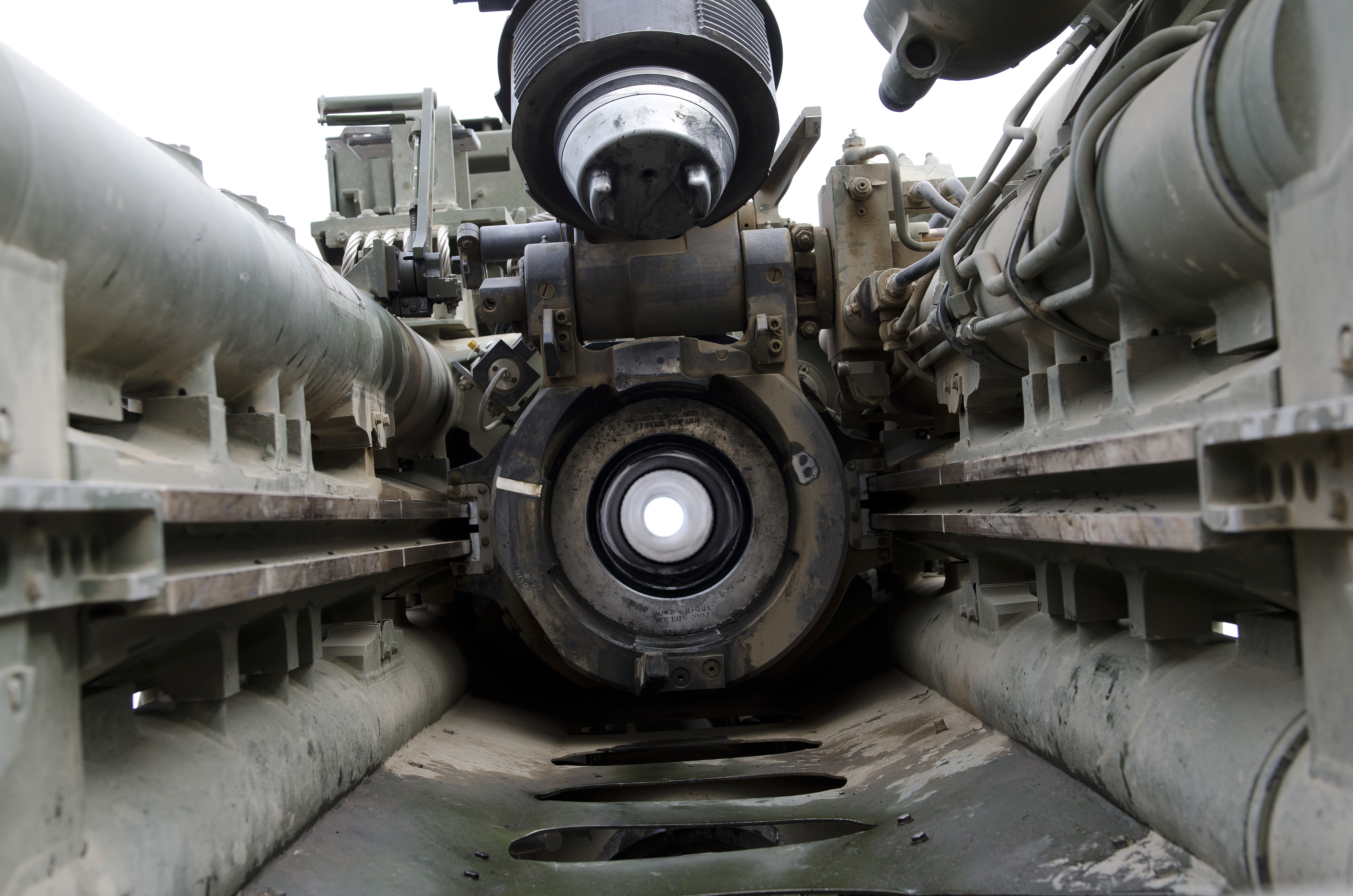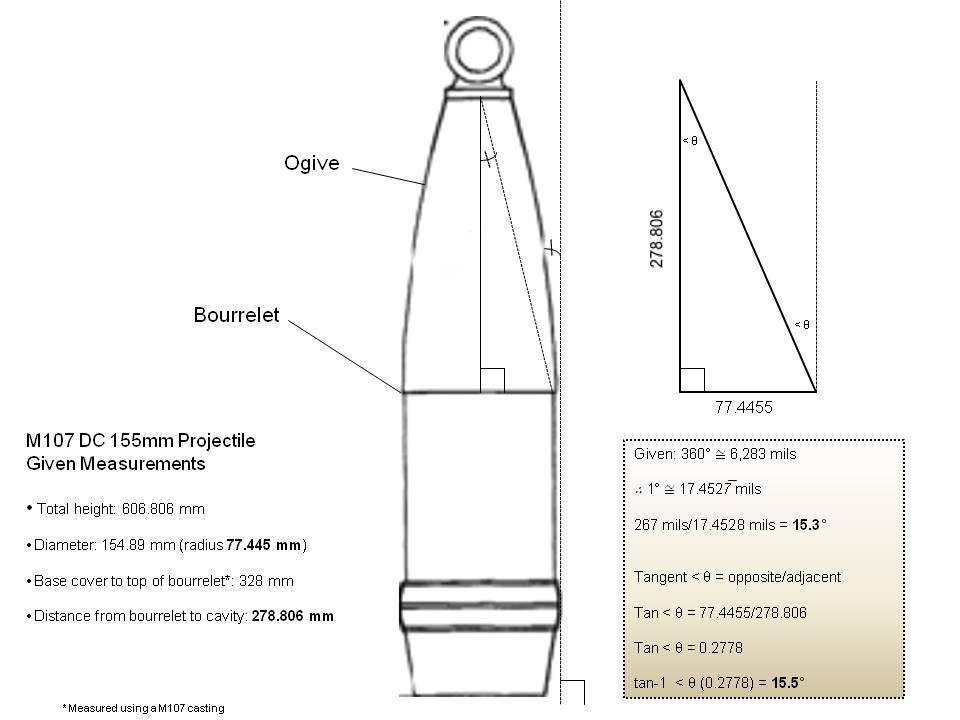267 mils: The rule every Artilleryman knows and why the DIVARTY must get rid of it
By 1LT David R. Williams

A view through the barrel of a M777A2. Photo courtesy of 1LT David R. Williams

A view through the barrel of a M777A2. Photo courtesy of 1LT David R. Williams
Special Thanks: The author would like to especially thank CPT Grady Stebbins, Training Development Manager, 1-30TH Field Artillery, Fort Sill, Okla., for his years of mentorship and valuable input in this article.
In his seminal order, former U.S. Army Forces Commander, GEN Daniel Allyn reinstituted the division artillery (DIVARTY) this past April in part to “restore the art and science of synchronizing effects” in the Field Artillery. This notion goes hand-in-hand with new precision oriented principles previously codified in this journal by BG Christopher Bentley, former commandant of the U.S. Army Field Artillery School, with his new “80-10-10” targeting standards. So if the Fires community is serious about applying modern science in its doctrine, given the resurrection of the DIVARTY, then it must disenthrall itself from the past if it is to revitalize its primary warfighting function of delivering Fires for the future.
Start with the executive officer’s minimum quadrant (min QE). Every artilleryman at some point in his career has computed it for his firing point. Like most gunnery solutions, the math behind it is rather elementary. Yet it factors in the esoteric concepts of site-to-crest, vertical interval, the nonriggidity of a projectile’s ballistic flight path, gravity, and dispersion. But when a firing point’s immediate and visible crests are small or very distant, then the sum of the five angles of min QE often tally to be less than a number range control says is sufficient to mitigate the danger of skipping rounds. Every artilleryman knows that number: 267 mils.
But where’s the proof? A white paper does exist. It cites a reputable if antiquated 1945 study by a prominent scientist, Garrett Birkhoff, formerly of the U.S. Army Ballistic Research Laboratories. His work, according to when the white paper was written, was still considered the definitive study on ricochet probability. Birkhoff found that skipping primarily occurs when the angle of fall is between 107 and 533 mils (or 6 degrees and 30 degrees). And the kicker of his study, which reverberates still today, “for an incident angle of 15 degrees or less, half of the projectiles normally can be expected to ricochet if the fuze does not function” (emphasis added). Of course, 15 degrees roughly equates to 267 mils, but how and why did Birkhoff incidentally select this angle?
It is the purpose, then, of this paper to mathematically show how and why 267 mils was selected by Birkhoff, and explain why the DIVARTY should, nearly 70 later, relinquish that number as a hard-and-fast and unscientific rule applicable to all howitzer, projectile, fuze, and propellant combinations.
First, let’s really distill 267 mils. We know from the mil-relation formula that an angle of one mil will subtend an arc of one meter at a distance of 1,000 meters. We also know that the circumference of an entire circle is two multiplied by its radius and the number pi. If we apply the mil-relation formula properly, we realize that because pi is an irrational number, there are not 6400 mils in 360 degrees, as is commonly presumed, but rather 6283 mils (two multiplied by 1,000 and pi expressed to the nearest ten-thousandths). One degree, then, equals 17.4527 mils with the number seven repeating to infinity. This number divided into 267 equals about 15.3 degrees.
Now observe an artillery projectile, say the 155 mm M107 deep cavity. Refer to Figure 1. Notice the angle formed by drawing an imaginary line perpendicular to the ground and tangent to the intersection of the ogive and the bourrelet. Is there a way to geometrically measure that angle? We can form a right triangle inside the projectile itself using the radius of the round at the top of the bourrelet as the base, then forming a right angle by extending a line from the center to the cavity itself, and then drawing the hypotenuse along the diagonal arch of the ogive back to the bourrelet. Next, we know the diameter of a M107 projectile is actually 154.89 mm (radius 77.445 mm) and its height without the nose plug is 606.806 mm (Technical Manual 43-0001-28). The radius of the projectile is the base length in our right triangle, and its height is the total height of the projectile less the height from the base cover to the bourrelet. The base of our right triangle divided by its height equals a certain ratio seen in Figure 1. If we apply arctangent – a trigonometric function that yields a certain angle given the ratio of the length of the opposite side of that angle to the length of its adjacent side – to that ratio we compute an angle of 15.5 degrees. Now refer again to the same perpendicular line tangent to the intersection of the ogive and bourrelet. Knowing that both the vertical line of our right triangle and that perpendicular line are parallel, and using the hypotenuse as a transversal cutting both lines, we know from simple geometry that those alternate interior angles, represented by the Greek letter theta in Figure 1, are congruent. We, therefore, know that the angle formed at the intersection of the ogive and bourrelet is 267 mils (the difference between 267 mils mathematically converted to degrees (15.3 degrees) and my calculations (15.5 degrees) is most likely due to miniscule errors in measuring the height of the round from the bourrelet to the nose-plug, which in this case if we solve backwards for the height of our right triangle using 15.3 degrees for theta in our equation, we realize that I likely measured the height incorrectly by four millimeters).
It seems Birkhoff selected this ‘incident’ angle of 267 mils as the universal min QE with the intent that all rounds impact at an angle greater than the one created by the ogive so as to prevent the bourrelet from striking the ground first, skipping, and thus creating an undetonated ordnance barreling across the ground if the fuze failed to function. This is fairly reasonable. Keep in mind, too, his era. The reliability rate of fuzes in 1945 was probably close to 50 percent, so a statistical analysis based on a coin flip was appropriate. Our modern arsenal provides us a dependency rate of about 98.3 percent to 99 percent across most fuze models, with the lowest being the delay setting of the M782 Multi-Option Fuze for Artillery (MOFA) at 93.7 percent, according to the Program Executive Office Ammunition. In addition, Birkhoff’s study was released prior to the publication and enforcement of surface danger zones (SDZ) – Areas A, B, C, D, and E – and probable error, all of which take into exhaustive account about every conceivable delivery outcome of an artillery round. Those buffer zones alone reduce the probability of a miss outside the SDZ to one in one million. The safety conscious training calculations and restrictions baked into the artillery impact areas of today just did not exist in his time.
The main problem, however, with Birkhoff’s ‘incident’ angle is that he did not have the thorough firing tables we do today and simply did not know each charge delivers its own unique quadrant that will deliver a round at an angle of fall of 267 mils.

Figure 1. Illustration courtesy of 1LT David R. Williams
This can be verified by exact statistics. Refer to Figures 1 and 2, which consolidates data from Columns 1 and 8 in Table G of FT-155-AM-3 and FT-155-AR-2 across all Modular Artillery Charge System (MACS) propellants. All answers are mathematically interpolated. The data speaks for itself. Regardless of propellant used, under standard conditions all rounds fired at 267 mils impact at an angle greater than 267 mils. This should be innate to the artillery community in the 21st Century. Projectiles do not follow a parabolic path, which Birkhoff knew, due to the retarding effects of our atmosphere (see Figure 2). This effect was even understood by Galileo in the 17th century when he first posited the parabolic paths of artillery projectiles and inherently knew his equations only held true when applied in a vacuum. It seems forgotten in 2014. If the artillery community properly understood this principle, then it would in fact select a lower quadrant to achieve an angle of fall of 267 mils.
| Propellant Charges | Angle of Fall (mils) if Fired at Elevation 267 mils | Elevation (mils) Fired if Desired Angle of Fall = 267 mils |
|---|---|---|
| M231 1L | 297 | 242 |
| M231 2L | 348 | 204 |
| M232A1 3H | 413 | 173 |
| M232A1 4H | 465 | 158 |
Figure 2. Illustration courtesy of 1LT David R. Williams
We observe, furthermore, that lower charges, particularly M231 1L, realize the most symmetrical trajectories, while higher charges experience the most asymmetrical. Four increments of charge M232A1, for example, fired at a quadrant of 267 mils with a M107 deep cavity (DC) projectile will impact at 465 mils, while a round fired with one increment of M231 will, at the same quadrant and shell-fuze combination, will impact at 297 mils. In addition, each propellant charge has its own min QE and it is inversely related to the amount of charge fired; higher charges require less quadrant in order to deliver a round at an angle of fall of 267 mils, and vice versa. Return to charge M232A1 4H in AM-3. The howitzer needs only 158 mils of quadrant to deliver a round with an angle of fall of 267 mils. It is, therefore, a self-evident truth that a universal min QE across all propellants unnecessarily restricts firing batteries, particularly when using hotel charges. The rule of 267 mils is only a reasonable rule-of-thumb when firing M231 1L, and even then it is imperfect and based not on empirical truth of known ballistic data, but rather a reliance on residual and outmoded knowledge from the World War II era.
It clear, then, from pure geometry and the military’s own ballistic data, that clinging to a universal rule of 267 mils is not only unscientific, but perhaps worse it unnecessarily restricts units from realizing the full benefit of firing across a broader spectrum of quadrants. This sort of obsolete mode of thinking, evidenced in the 267-mil rule, prevents the artillery from fully synchronizing Fires even if a firing point’s terrain accommodates lower quadrants. I recommend, therefore, keeping in mind the intent for all rounds to impact at an angle greater than the ogive, and given the reliability rate of modern fuzes and our extensive SDZ analyses, that min QE should be charge dependent in accordance with Figures 1 and 2 of this article, and promulgated by each DIVARTY so as to allow units, as Allyn put it, to better synchronize the effects of cannon artillery Fires.